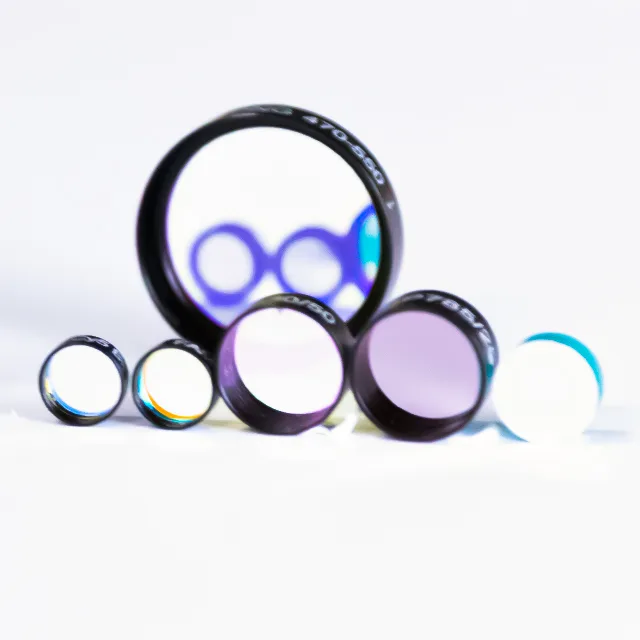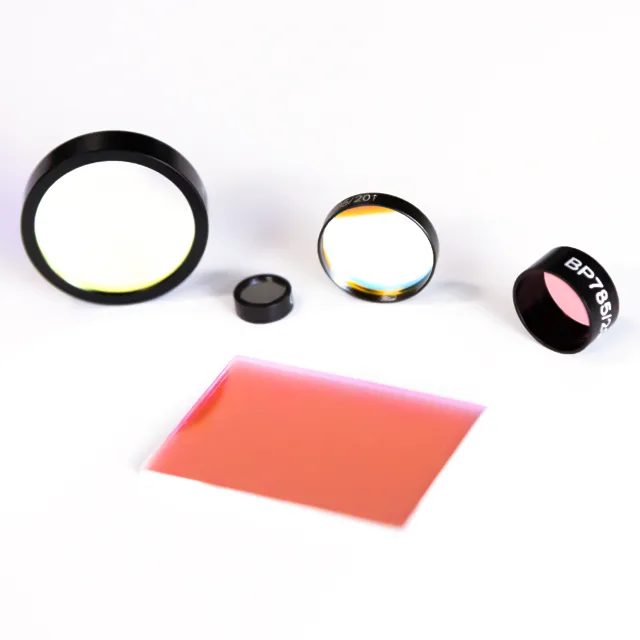Optical filters are devices that can control the passage or blocking of light of a specific wavelength. They are used in many scientific and industrial applications, such as microscopy imaging, spectral analysis, laser communications, etc.
Different application scenarios have different requirements for optical filters. Many people wonder if we can customize optical filters for specific application scenarios to meet these specific requirements. The answer is yes. This article will explore some of the benefits of customizing optical filters and how to customize optical filters.
What is an Optical Filter?

An optical filter is a device that can selectively pass certain wavelengths of light while blocking other wavelengths. They are often used in various optical systems to achieve specific optical effects or improve system performance.
According to their functions, optical filters can be divided into several types, such as bandpass filters, low-pass filters, high-pass filters, and band-stop filters. Different types of filters have different application scenarios and material choices, such as glass, polymers, or specific coating materials.
Why Do You Need Custom Optical Filters?
In many high-precision applications, standard optical filters may not fully meet specific needs. For example, astronomical research requires extremely precise spectral selectivity, medical imaging requires light transmission at specific wavelengths, and laser systems may require highly customized filters to optimize the output beam.
Custom optical filters can precisely adjust wavelength, transmittance, size, and shape to meet these specific application needs, thereby overcoming the limitations of standard filters.
Advantages of Custom Optical Filters
The main advantage of custom optical filters is that they can provide higher precision and performance. For example, in laser systems, using custom filters can reduce the number of optical components, thereby reducing system complexity and cost.
Custom filters can also optimize the signal-to-noise ratio, and improve system efficiency and imaging quality, especially in optical systems that require high resolution.
Which Filters Can Be Customized?

Taking the Optolong website as an example, they provide customization services for various types of filters to meet the specific needs of different applications. The following are several types of filters that can be customized:
1. Bandpass Filters
Definition and Function: Bandpass filters allow a specific range of wavelengths to pass through while blocking other wavelengths. These filters are widely used in applications such as astronomy, microscopy, and laser systems.
Customization Options: The filter range (center wavelength and bandwidth), size, shape, and coating material of the filter can be customized. The transmittance and cutoff depth of the filter can be adjusted to achieve optimal performance based on the specific needs of the customer.
2. Longpass Filters
Definition and Function: Longpass filters allow light longer than a certain wavelength to pass through while blocking light shorter than that wavelength. This type of filter is often used in applications where short wavelengths of light (such as ultraviolet light) need to be removed.
Customization Options: Customizable parameters include cutoff wavelength, slope, size, and shape. The choice of material (such as glass or polymer) and coating type (such as anti-reflective coating) can also be customized based on specific application requirements.
3. Shortpass Filters
Definition and Function: Shortpass filters allow light shorter than a certain wavelength to pass through while blocking light longer than that wavelength. They are often used in optical systems to isolate or filter out specific short-wavelength light.
Customization Options: The cut-off wavelength and other optical properties, such as optical density (OD value) and transmittance, can be selected as needed. The physical size and shape of the filter can also be customized to fit different optical systems.
4. Neutral Density Filters
Definition and Function: Neutral density filters (ND filters) reduce the transmittance of all wavelengths of light and are usually used to reduce the intensity of incident light without changing its color. These filters are often used in photography, microscopy, and laser experiments.
Customization Options: The optical density of ND filters (e.g. 0.3ND, 0.6ND, 1.0ND, etc.) can be customized according to application needs. In addition, the size, shape, and material (such as optical glass or quartz) of the filter can also be customized according to requirements.
5. UV and IR Cut Filters
Definition and Function: UV and IR cut filters are used to block ultraviolet or infrared light and pass light in the visible spectrum. Such filters are often used in photography and visual applications to prevent ultraviolet or infrared light from interfering with image quality.
Customization Options: Customizable parameters include the choice of UV and IR cutoff wavelengths, transmission range, filter size, and thickness. The material and coating type of the filter can be selected according to requirements to optimize performance.
6. Polarizing Filters
Definition and Function: Polarizing filters can selectively transmit light of a certain polarization direction while absorbing or reflecting light of other polarization directions. This filter has important applications in eliminating reflected light and enhancing contrast and color saturation.
Customization options: The type of polarization filter (such as linear polarization or circular polarization), transmittance, optical axis direction, and size can be customized. Materials and coatings can also be customized according to the requirements of specific applications.
7. Linear Variable Filters
Definition and function: Linear variable filters are characterized by their transmission spectrum changing with position. This type of filter is suitable for applications that require dynamic wavelength adjustment, such as spectrum analyzers.
Customization options: Customizable parameters include wavelength range, bandwidth, filter size and shape, and other optical properties. Material and coating selection can also be adjusted according to requirements.
8. Dual-band or Multi-band Filters
Definition and function: Dual-band or multi-band filters can transmit two or more bands of light simultaneously while blocking other wavelengths. These filters are often used in applications that require detection or analysis of multiple light sources.
Customization options: The number of bands, wavelength range, bandwidth, filter size, and shape can be customized. Material selection and coating design can also be adjusted according to requirements.
9. Laser Line Filters
Definition and Function: Laser line filters are specially designed to transmit laser beams of specific wavelengths while blocking light of other wavelengths. This type of filter is widely used in laser measurement and communication.
Customization Options: The center wavelength, bandwidth, transmittance, and size of the filter can be customized. Different materials and coatings can also be selected to meet different laser application requirements.
10. Interference Filters
Definition and Function: Interference filters use the principle of multi-layer thin film interference to selectively transmit certain wavelengths of light while blocking other wavelengths. This type of filter has important applications in optical microscopes, spectrometers, and remote sensing equipment.
Customization Options: The center wavelength, bandwidth, transmittance, filter size, and thickness can be customized as needed. The coating material and number of layers can be adjusted according to spectral requirements.
Optolong offers a wide selection of custom optical filters, from precise bandpass filters to powerful multi-band filters, each filter type can be tailored to the specific needs of our customers to provide optimal performance and precision.
How to Customize Optical Filters?

Step 1: Demand Analysis
First, the specific requirements of the application need to be clarified, including wavelength range, bandwidth, cut-off range, transmittance and reflectivity, size, surface shape, smoothness requirements, etc.
For high-precision applications, demand analysis is particularly important to ensure that the design of the custom filter can meet the system requirements.
Step 2: Design Selection
Optical design software and simulation tools are used to optimize the design parameters of the filter, such as central wavelength, bandwidth, and cutoff depth. The accuracy of the design directly affects the performance of the filter.
Step 3: Material Selection and Coating Design
Material selection and coating design are key steps in customizing optical filters. Choosing the right material and coating type ensures that the filter achieves the desired optical performance, such as high transmittance and low reflectivity.
Step 4: Manufacturing and Testing
The manufacturing of custom optical filters involves multiple steps, including optical coating, cutting, and grinding. After manufacturing, rigorous performance testing is required to ensure that the filter meets the design specifications.
Considerations for Customized Optical Filters
During the customization process, some challenges may be encountered, such as cost, manufacturing time, and technical limitations. Therefore, it is crucial to choose an experienced supplier or manufacturer. At the same time, quality control should not be ignored to ensure the performance and reliability of customized products.
Application Examples of Customized Optical Filters
For example, in high-resolution microscopy, customized optical filters can significantly improve imaging quality and contrast. In spectrometers, customized filters of specific wavelengths can help resolve subtle spectral features and improve the accuracy of analysis.
Conclusion
Customized optical filters are not only feasible but also necessary in many cases. Through customization, optical systems can achieve better performance and precision to meet specific application requirements. Whether it is astronomy, medical imaging or laser systems, customized optical filters can provide significant advantages and improvements and deserve extensive consideration and application.
OPTOLONG website provides customization options, which usually include wavelength range, bandwidth, transmittance, size, shape, material selection, etc., providing flexible solutions for different application scenarios. If you have specific application requirements, please feel free to contact us for detailed customization advice and support.
Related reading: What is Dichroic Mirror?
